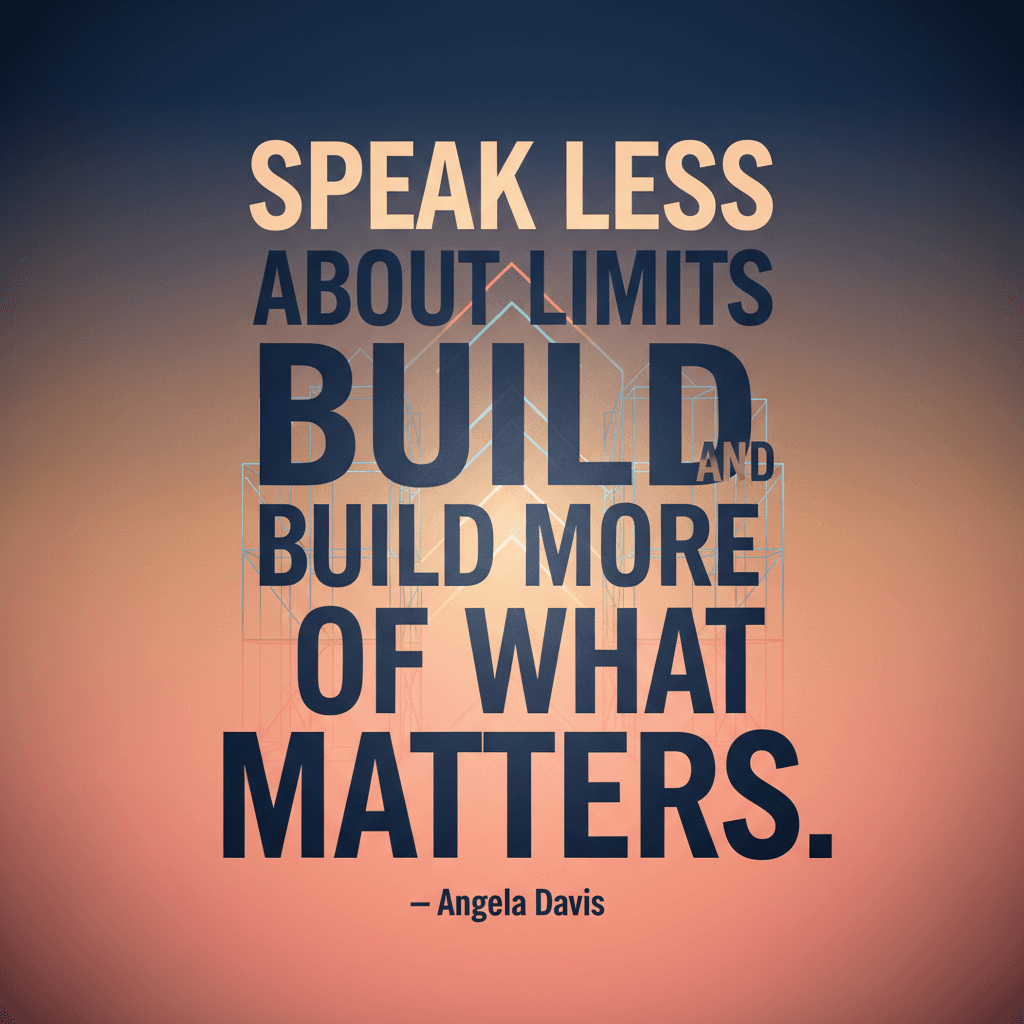From Limits to Building What Truly Matters

Speak less about limits and build more of what matters. — Angela Davis
From Constraint Talk to Constructive Praxis
At the outset, Angela Davis’s imperative reframes change as a building project: less dwelling on what cannot be done, more crafting what must exist. In Freedom Is a Constant Struggle (2016), she consistently links critique to creation, arguing that resistance achieves durability only when it generates institutions, relationships, and practices that outlast the moment. Thus, talk of limits becomes a design brief rather than a dead end, moving us from lament to layout and from analysis to assembly.
Abolition as Institutions of Care
Next, abolition offers a concrete illustration of building over mere objection. In Are Prisons Obsolete? (2003), Davis urges us to replace punitive default settings with care-centered infrastructures. Programs like CAHOOTS in Eugene, Oregon—dispatching medics and counselors to behavioral health calls—show how alternatives reduce harm while meeting needs. In this spirit, André Gorz’s “non-reformist reforms” (1968) describe changes that prefigure the future we want: crisis centers, restorative justice circles, and housing-first models that decriminalize poverty by making care present, not theoretical.
Designing Forward: A Bias Toward Action
In practice, social change benefits from a designer’s posture: prototype, test, iterate. IDEO’s popular “bias toward action” and the Stanford d.school’s rapid prototyping ethos highlight how small pilots can reveal what speeches cannot. Violence interruption models like Cure Violence (Chicago, 2000) similarly test tangible interventions—deploying credible messengers, tracking hot spots, and adjusting in real time. By treating limits as constraints to design around, movements translate vision into workable systems rather than waiting for perfect conditions.
Measuring What Matters: Capabilities, Not Just Inputs
Moreover, building requires measures that reflect lived freedom. Amartya Sen’s capability approach in Development as Freedom (1999) shifts attention from resources to real opportunities—can people be safe, educated, housed, and free to act? Accordingly, relevant indicators include eviction rates, time to access mental health care, infant and maternal mortality, and community trust. When we quantify these outcomes, budgets, policies, and prototypes align with purpose, ensuring that “what matters” is not rhetorical but trackable.
Education That Trains Builders, Not Bystanders
Meanwhile, pedagogy becomes a tool for construction. Paulo Freire’s Pedagogy of the Oppressed (1970) rejects banking models of education in favor of co-created inquiry that equips learners to redesign their worlds. Porto Alegre’s participatory budgeting (1989) shows this at city scale, where residents deliberate trade-offs and directly allocate funds, often steering resources toward sanitation, transit, and underserved neighborhoods. By learning through making, communities acquire the habits necessary to sustain the institutions they invent.
Climate Justice and the Infrastructures of Survival
Likewise, climate justice demonstrates how building supplants despair. Casa Pueblo in Adjuntas, Puerto Rico, installed community solar that kept critical services running after Hurricane Maria (2017), turning resilience into a neighborhood utility rather than a slogan. Community land trusts such as Boston’s Dudley Street Neighborhood Initiative (founded 1988) secure affordability while enabling green retrofits. In each case, the work foregrounds infrastructures—energy, housing, food—that make ecological commitments plausible in daily life.
From Rhetoric to Rhythm: Daily Practices
Finally, the shift from limits to building demands rhythm: weekly “build hours” for mutual aid logistics, standing after-action reviews to learn fast, and public work logs that invite help. Ruth Wilson Gilmore’s line that “abolition is about presence, not absence” (interviews c. 2014) reminds us to institutionalize care: crisis response teams, tenant unions, harm-reduction sites, and worker co-ops. By ritualizing small, compounding acts, we anchor hope in structures—so speaking less about limits becomes possible because what matters is already under construction.